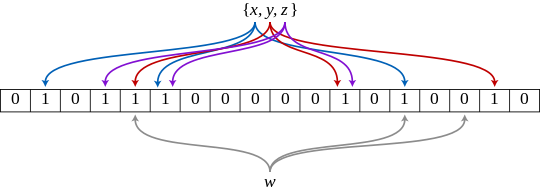資料結構筆記 - 布隆過濾器 Bloom Filter

Summary
- 用途: 用來快速判斷元素是否存在於一個集合中
- 優點: 快速、節省空間
- 缺點: 可能有 false positive (不存在但判定為存在)
- 應用:
- Check Duplicate: name、email 等是否已被使用
- Filters: 過濾惡意請求 (ex: Cache penetration)、垃圾郵件等
原理
對元素使用 k 個 Hash Functions,將其映射到長度為 m 的 Array 中,寫入時將映射到的 k 個位置標示為 1,檢查時如果映射到的 k 個位置都命中,表示該元素可能存在。
由預期的 False positive rate (p) 以及存入的資料筆數 (n) 來求出 Array Size (m) 以及 Hash Functions數 (k)
- False positive rate

- Array size

- Number of hash functions

- False positive rate
選擇 Hash function
可以使用 Non-Cryptographic Hash (非密碼雜湊函數),雖然有 collision 的可能,但足夠好了,而且比較快。
例如: MurmurHash、FarmHash、SpookyHash
實作
非原創! 基本上是下面參考文章中的程式碼,寫的很不錯所以只有小小修改一下。1
2
3
4
5
6
7
8
9
10
11
12
13
14
15
16
17
18
19
20
21
22
23
24
25
26
27
28
29
30
31
32
33
34
35
36
37
38
39
40
41
42
43
44
45
46
47
48
49
50
51
52
53
54
55
56
57
58
59
60
61
62
63
64
65
66
67
68
69
70
71
72
73
74
75
76
77
78
79
80
81
82
83
84
85
86
87
88
89
90
91
92
93# Python 3 program to build Bloom Filter
# Install mmh3 and bitarray 3rd party module first
# pip install mmh3
# pip install bitarray
import math
import mmh3
from bitarray import bitarray
class BloomFilter(object):
'''
Class for Bloom filter, using murmur3 hash function
'''
def __init__(self, items_count, fp_prob):
'''
items_count : int
Number of items expected to be stored in bloom filter
fp_prob : float
False Positive probability in decimal
'''
# False possible probability in decimal
self.fp_prob = fp_prob
# Size of bit array to use
self.size = self.get_size(items_count, fp_prob)
# number of hash functions to use
self.hash_count = self.get_hash_count(self.size, items_count)
# Bit array of given size, default all 0
self.bit_array = bitarray(self.size)
def add(self, item):
'''
Add an item in the filter
'''
digests = []
for i in range(self.hash_count):
# create digest for given item.
# i work as seed to mmh3.hash() function
# With different seed, digest created is different
digest = mmh3.hash(item, i) % self.size
digests.append(digest)
# set the bit True in bit_array
self.bit_array[digest] = True
def check(self, item):
'''
Check for existence of an item in filter
'''
for i in range(self.hash_count):
digest = mmh3.hash(item, i) % self.size
if self.bit_array[digest] == False:
# if any of bit is False then,its not present
# in filter
# else there is probability that it exist
return False
return True
def get_size(n, p):
'''
Return the size of bit array(m) to used using
following formula
m = -(n * lg(p)) / (lg(2)^2)
n : int
number of items expected to be stored in filter
p : float
False Positive probability in decimal
'''
m = -(n * math.log(p))/(math.log(2)**2)
return int(m)
def get_hash_count(m, n):
'''
Return the hash function(k) to be used using
following formula
k = (m/n) * lg(2)
m : int
size of bit array
n : int
number of items expected to be stored in filter
'''
k = (m/n) * math.log(2)
return int(k)
看一下成果1
2
3
4
5
6
7
8
9
10
11
12
13
14
15
16
17
18n = 100000 # Number of items to add
p = 0.05 # False positive probability
bloomf = BloomFilter(n,p)
print("Array size: {}".format(bloomf.size))
print("Number of hash functions: {}".format(bloomf.hash_count))
print("False positive probability: {}".format(bloomf.fp_prob))
# Add items
for i in range(n):
bloomf.add(str(i))
# Check false positive rate on Test data
fp = 0
for i in range(n, 2*n):
if bloomf.check(str(i)):
fp += 1
print("False positive rate on test data: {:.4f}".format(fp/n))
可以看到實際的 FP Rate 與我們設定的非常接近。
